 |
Fortaleza de Santa Teresa
Rocha, Uruguay
|
|
 |
Constructed: 1765-1800
Used by: Portugal, Spain, Brazil, Uruguay
Conflicts in which it participated:
Uruguayan War of Independence,
The Great War
(in an oblique fashion)
|
As is so frequently the case with starforts that were built anywhere other than Europe, our story begins when the white guys showed up. The Portuguese first arrived in what is today Uruguay in 1512, the Spanish in 1516. Neither found any gold or silver, but they did find plenty of locals who were violently disinterested in being colonized.
Though there was nothing either Spain or Portugal particularly wanted in the region, they were both very interested in Brazil, which lies directly to the north. Brazil became a vastly important Portuguese colony in the 16th century, and Spain wished to make things difficult for their Lusitanian cousins.
|
 |
|
|
At the start of the 17th century Spain introduced cattle to Uruguay ("Cattle, meet Uruguay!!"), and stepped up its colonization efforts, in a calculated move to check Portuguese expansion south from Brazil. This took place during the period in which Portugal was joined with Spain in a "dynastic union," due to a succession crisis when Portugal's King Sebastian I (1554-1578) was killed in battle in Morocco, and then his successor, King/Cardinal Henry (1512-1580) died of natural causes shortly thereafter. Henry, being a chaste clergyman, of course had no heirs, a lack which seems like something somebody should have noticed aforetime, but royal processions were delicate, weird things under the best of circumstances.
Regardless, during the Iberian Union (1580-1640) betwixt Spain and Portugal, the latter nominally controlled its overseas possessions, but the former was pulling the levers of power. That Spain was still concerned with Portuguese expansion south of Brazil, however, suggests that they didn't expect this Union to last forever.
|
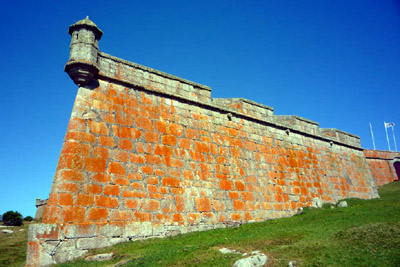 The bright orange color of the Fortaleza helps it to blend seamlessly into its surroundings, enabling it to stalk its prey. The bright orange color of the Fortaleza helps it to blend seamlessly into its surroundings, enabling it to stalk its prey. |
 |
John IV (1604-1656), "The Restorer," led Portugal in the Restoration War, which began the process of chasing Spain out of Portuguese politics in 1640. Spain didn't finally admit defeat until 1668, whereupon Portugal moved immediately to reestablish control over its colonies. A Portuguese fort was built at Colonia del Sacramento, at the mouth of the Uruguay River at present-day Uruguay's southwestern extent, from 1669 to 1671.
The Spanish, still interested in maintaining a stronghold to Brazil's south, began fortifying Montevideo, 180 miles to the east of Colonia del Sacramento, at the start of the 18th century. |
|
Portuguese counter-fortification-moves in that city followed, and the momentary matter of Montevidian supremacy was decided by the arrival of a Spanish force from nearby Buenos Aires, in what is today Argentina, but was then Spain's Viceroyalty of Río de la Plata.
The authorities of Portugal and Spain tried to delineate borders in the region with a series of treaties, but continued to bump into each other due to treaty after treaty making adjustments that bore little relation to what was going on for the folks on the ground. It was this uncertainty and conflict that led to the construction of the Fortzleza de Santa Teresa, as part of a fortified line intended to check a Spanish advance.
|
With hostilities in the area imminent, the Portuguese began construction on the Fortaleza de Santa Teresa, named for canonized Spanish mystical nun Teresa de Jésus (1515-1582), in October of 1762. Unfortunately the Spanish moved faster than whomever the Portuguese had coerced into building their newest starfort, and the Fortaleza was in a less-than stellar state when around 3,000 Spaniards arrived to challenge it. Little more than a series of ditches and strategically-placed sticks, the fort was taken by the Spanish without a fight.
Upon returning home, the Portuguese commander on the scene, Lieutenant Colonel Tomás Luis de Osorio, was later found guilty of inadequately defending his ditch-and-stick starfort with its 100-man garrison, and was hung in Lisbon for his efforts.
|
 |
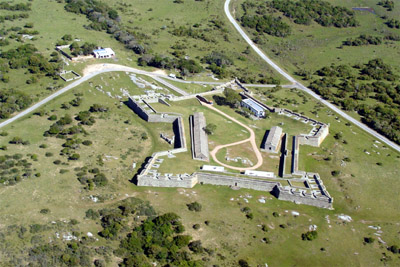 From this angle, the Fortaleza de Santa Teresa looks a bit like another Portuguese fort, Fort Jesus, in Mombasa, Kenya. Fort Jesus was intended to be shaped like a man, was this Fortaleza intended to be shaped like Santa Teresa herself? Doubtful. Any woman who was that angular would never have been canonized. From this angle, the Fortaleza de Santa Teresa looks a bit like another Portuguese fort, Fort Jesus, in Mombasa, Kenya. Fort Jesus was intended to be shaped like a man, was this Fortaleza intended to be shaped like Santa Teresa herself? Doubtful. Any woman who was that angular would never have been canonized. |
|
Spain found this newest conquest to be an excellent place at which to build a starfort oriented against Portuguese Brazil. Building upon the existing Portuguese foundations and using leftover building materials from the fort's previous owners, the Spanish built the Fortaleza de Santa Teresa version 2.0, and then continued their march. The Treaty of San Ildefonso (1777) concluded this most recent bout of fighting betwixt the Spanish and Portuguese, and officially gave the Fortaleza of our current interest to Spain. The fort's exterior walls were complete by 1775, its interior structures around 1800.
|
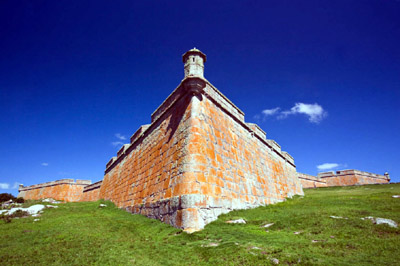 Goodness gracious. The glory. Goodness gracious. The glory. |
 |
As was the case in Europe, the Napoleonic Wars (1803-1815) changed everything in South America. The British got involved in the messing-around-in-South-America business during this conflict, seeing the war as a fine opportunity to take things that didn't belong to them. The British occupied Montevideo for several months in 1807, until chased out by the Spanish later that year.
The Napoleonic Wars destabilized Spain to the point that many of its ungrateful overseas colonies took advantage of their parent society's discomfiture and launched independence movements. |
|
This phenomenon reached Uruguay in 1811, and in May of that year the Fortaleza de Santa Teresa was captured by "patriotic forces," which likely means native folks. Portuguese troops returned to the area in July, and the locals attempted to destroy the fort before it could be recaptured, but destroying a properly-made starfort is no easy task...Which is why there are still so many of them around!
Neither Spain nor Portugal gave up their colonial possessions without fisticuffs, but their days of South American empire were at an end: Brazil attained independence in 1822, Uruguay in 1828 and Argentina in 1861. In 1825 as part of the Uruguayan Revolutionary War, our Fortaleza was captured by Uruguayan revolutionary leader Leonardo Olivera (1793-1863), whence the Portuguese tried on two occasions to forcibly oust him, unsuccessfully.
|
One Uruguay finally achieved independence, the Fortaleza de Santa Teresa was awarded, for its heroic assistance in the successful outcome of the war, abandonment and slow ruin. To be fair, when a nation is born from colonial strife, it has little in the way of funds to maintain its historic sites, and other immediate priorities. The fort was right on the border with Brazil, however, so it was utilized as a watchtower from 1830 to 1843.
The Fortaleza got to return to its role as defensive fortification during the Guerra Grande (Great War)(1839-1851), which is not to be confused with the Great War (1914-1918).
|
 |
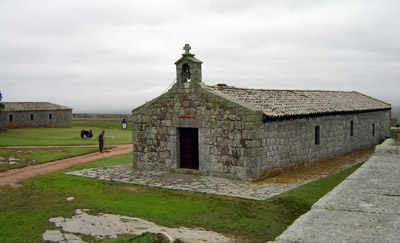 A Spanish or Portuguese fort just wouldn't be a Spanish or Portuguese fort without a large portion of its insides being taken up by a chapel! A Spanish or Portuguese fort just wouldn't be a Spanish or Portuguese fort without a large portion of its insides being taken up by a chapel! |
|
This conflict, started by squabbling political personalities in Uruguay, Argentina and Brazil, expanded to include intervention by Britain, France, Spain and none other than the Later-to-be-Father of a United Italy, Guiseppe Garibaldi (1807-1882), who taught math classes locally when not actively revolutionizing. Unfortunately none of these interesting parties inhabited our Fortaleza, though it was occupied for a period by the forces of Manuel Oribe (1792-1857), a previous president of Uruguay, who was on the losing side of this war.
|
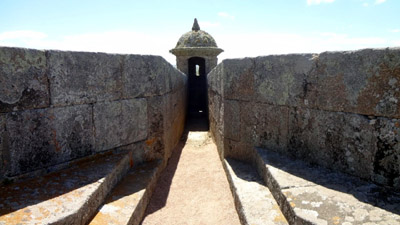 A garita attached to what I would like to definitively say is our Fortaleza, although there is another, strikingly similar starfort about 30 miles to the north called the Fuerte da San Miguel, built around the same time for much the same purpose, of which some pictures are misidentified as our current Fortaleza. But even if this garita isn't affixed to the starfort I think it is, rest assured that the Fortaleza's garitas look very much like this one. A garita attached to what I would like to definitively say is our Fortaleza, although there is another, strikingly similar starfort about 30 miles to the north called the Fuerte da San Miguel, built around the same time for much the same purpose, of which some pictures are misidentified as our current Fortaleza. But even if this garita isn't affixed to the starfort I think it is, rest assured that the Fortaleza's garitas look very much like this one. |
 |
The Great War turned out to be the Fortaleza de Santa Teresa's last war. Abandoned upon the end of hostilities, the Fortaleza served as "shelter for cattle and bats," not to mention countless insects and micro-organisms, which are far less interesting than cattle and bats.
In 1895 the cattle, at least, were shoved aside and the Fortaleza set up shop as a prison for what must have been a brief period of joyous incarceration for some lucky individuals...and local interest in the fort's restoration began to swell up from the earth at the beginning of the 20th century. A commission was established to that end in 1923, and in 1927 the Fortaleza was declared a national monument. |
|
The Fortaleza's reconstruction was complete in the 1940's, at which time it opened to the public as a site of military/historical interest. According to local legend, five local mermaids formed the Fortaleza de Santa Teresa's five bastions, and/or the hills around the fort. These mermaids were named Caaibaté, Maci, Manipeya, Cuñataí and Alúa. Yes sir, nothing but the facts at Starforts.com!
|
And speaking of facts, I was very excited when I first mapped the Fortaleza de Santa Teresa, because it seemed to be further south than what I had previously thought to be the world's southernmost starfort, the Castle of Good Hope in Cape Town, South Africa. Drawing a horizontal line on the map seems to prove the two forts are almost exactly equally southern, however. The latitude of the two are extremely close, with the Castle of Good Hope being at -33.926, and the Fortaleza de Santa Teresa at -33.973, making the Fortaleza the winner of the coveted Southernmost Starfort crown by a whopping .047! Ladies and gentlemen, we have a new southernmost starfort! Well actually an old southernmost starfort, but new to me, which is really what matters here. |
 |
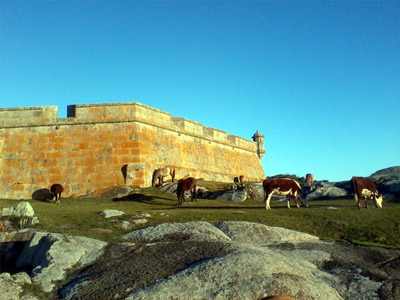 The cattle contingent of the Fortaleza de Santa Teresa's Cattle and Bats conglomeration. The cattle contingent of the Fortaleza de Santa Teresa's Cattle and Bats conglomeration. |
|
2020 Update on the World's Southernmost Starfort: Regardless of how excited I was over that .047 in 2018, it has since been revealed that the world's southernmost starfort is actually Chile's Fuerte de Niebla, which clocks in at the astounding latitude of -39.870. Take that, ill-informed 2018 me! |
|
|
|
|
|
 |




